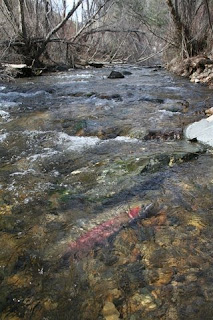
The nature of salmon recovery spans regions, cultures, geographies, and lifestyles. Because of this diversity of interests, efforts to restore salmon have become significantly disseminated. Small organizations and site-specific interest groups sprout up when existing organizations fail to align agendas, meet requests, or expand the scope of their projects. Unwilling to give up on the mission, energies are cleaved to form an organization in order to address the specific goals that were previously unattended.
At the agency level, workgroups are delegated to focus on particular issues affiliated with salmon restoration. Since taxpayer money is funding these types of restoration projects, advisory committees are formed for each region and/or project to ensure that the funding is being effectively utilized. It is common for each watershed to have their own council and some even have satellite organizations that while still associated, work on recovery issues in adjacent communities. Spanning the Pacific Northwest, there are thousands of NGO’s, community groups, industries, and governmental organizations working on one specific goal, salmon recovery, but do it in a way that fulfills a specific niche.
This diverse approach to salmon restoration can be beneficial by allowing each community to address and design projects to best fit their restoration needs. However, this has created a vast network of efforts that are detached from one another. Adding to this fragmentation is the competitive nature of applying for federal and private funding on which many organizations rely. As a result, communication and collaboration between groups hardly exists in most regions.
Maintaining status quo at this point is proving to be ineffective on the larger scale as the salmon populations continue to decline and the movement struggles to gain a political foothold. In order to truly create a strong and vibrant movement, organizations need to find a way to unite. This collaborative process can help eliminate redundant and overlapping projects which will then free up resources that can be redirected to areas of need. Personal agendas and small town politics inherent in this effort need to be reminded of the fundamental goal to restore salmon to our waterways. Organizations need to take the initiative to reach out to one another and start brainstorming ways to communicate, share ideas, and work together.
The timing is critical and the work is unprecedented to unify such an expansive and divergent movement, but the longer we wait the more we will lose. Uniting these energies will be advantageous by creating a lean, streamline, and efficient movement mimicking the very nature of the species it is fighting for.
So many metaphors here related to salmon! For example, how is it that the individual groups have been swimming upstream (absent of collaboration) and, in this great effort, lose sight of others? You've got a great opportunity and challenge here, Jo--I think an important piece will be not to "re-invent the wheel" and to balance the need for 'something new' on a foundation of what has been done to this point. Along these lines, it can be very helpful if you start looking around at other successful examples of multi-stake holder collaborations, that are in completely different fields. You may want to carve out some time this quarter to do some research/reading in this field, finding some good case studies to draw upon.
ReplyDeleteThe Summer 2009 issue of the Nature Conservancy Magazine had a focus on salmon restoration projects. I haven't read the articles yet to be able to vouch for them, but I suspect there is something good in here.
ReplyDeletehttp://www.nature.org/magazine/summer2009/features/
I also remember Don sharing an article with us about salmon restoration in southern Oregon during RP1 sometime.